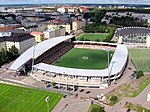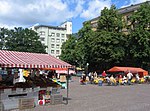Töölön Pallokenttä

Töölön Pallokenttä (Finnish: Töölön pallokenttä, Swedish: Tölö bollplan), also known by its nickname Bollis, is a football stadium in Helsinki, Finland. The stadium is located in the Töölö district and today it holds 4,000 spectators. Töölön Pallokenttä was originally built in 1915 and it was the first football stadium in Finland. The stadium was last renovated in 2000–2001. It hosts matches for Atlantis FC which plays in Kakkonen and HJK Helsinki women's team in the Finnish Kansallinen Liiga. In 1952 Summer Olympics the stadium hosted five football matches; Yugoslavia vs India, Hungary vs Italy, Sweden vs Austria, Germany vs Brazil and Yugoslavia vs Denmark.
Excerpt from the Wikipedia article Töölön Pallokenttä (License: CC BY-SA 3.0, Authors, Images).Töölön Pallokenttä
Urheilukatu, Helsinki Taka-Töölö (Southern major district)
Geographical coordinates (GPS) Address Nearby Places Show on map
Geographical coordinates (GPS)
| Latitude | Longitude |
|---|---|
| N 60.185833333333 ° | E 24.924722222222 ° |
Address
Töölön pallokenttä
Urheilukatu
00260 Helsinki, Taka-Töölö (Southern major district)
Finland
Open on Google Maps










